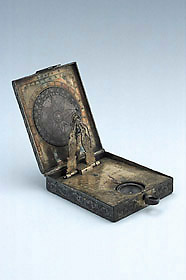
 |
| Catalogue |
 |
 Inclining Dial The outer face of the cover has a volvelle for converting between ordinary equal hours and Italian hours given the declination of the sun. The outer scale of equal hours runs 1 to 12, 1 to 12 and surrounds the set of lines numbered 1 to 24 for Italian hours. The horizon line is dotted and an index rule marked with a declination scale of zodiac signs turns about the centre. The edges of the plate identify the cardinal directions as 'SEPTENRIO', 'ORIENT', 'MERIDIES' and 'OCCIDENT'. The inside face of the cover also has a volvelle for converting equal and Italian hours, in this case given the time of sunset in equal hours. The fixed scale of hours runs 1 to 12, 1 to 12, divided to 1/2 and surrounds a silver disc with the scale of Italian hours 1 to 24 divided to 1/2 around its circumference. Inside the scale is the instruction 'HABETVR HORA ITALICA SI 24 PONAS SVPER HORAM OCCASVS'. The central portion of the disc is decorated with a star engraving and the edges of the plate have the same labelling of directions as the outer face. At the northern end of the plate is the signature '15 [star]M[star]P[star] 97'. This volvelle is all but identical to the type which appears in earlier instruments by Ulrich Schniep (see Epact 14108 for an example). The main box carries an inclining string-gnomon dial with a decorated folding gnomon support which is sprung perpendicular to the dial plate and incorporates a plummet. The plummet is positioned above a latitude scale from 40 to 52?, with dots every second degree, and the whole plate is pivoted to set the dial for latitude. Around the edge of the dial plate is a scale of equal hours 3 to 12 to 9, with the half hours marked by stars. The central portion of the dial plate is for Italian hours and its solar declination lines include 'TROPICVS CANCRI', 'AEQVATOR DIEI' and 'TROPICVS CAPRICOR'. Given the declination of the sun, the time in Italian hours can be read directly; alternatively, if the string gnomon had a suitably positioned knot or bead the sun's declination could be read off from the zodiac scales marked 'SIGNA CRESCENTE DIE' and 'SIGNA DECRESC: DIE'. The dial plate also has an inset compass 12 mm in diameter and its silvered base is marked for variation. On either side of the compass are decorative engraved tassels. On the underside of the instrument is a table marked 'Tabula latitudinis Regionum' giving the latitudes of 32 places in roughly alphabetical order. Provenance: Roussel Collection; Lewis Evans Collection G. 362. Stephen Johnston |



